Dell U2311H: E-IPS, Full Adjustments, and DisplayPort
by Chris Heinonen on September 27, 2011 12:20 AM ESTColor Accuracy
Next up I went to calibrate the monitor using an i1D2 colorimeter from Xrite and a copy of ColorEyes Pro using a MacBook Air as the test platform. Initially I attempted to do the calibration on my Windows 7 machine, but my video card seemed to have an issue with the LUTs and ColorEyes, as the dE performance got worse after the calibration than before. Performance on the Mac seemed to be correct and more in line with what is expected after a calibration.
One downside of ColorEyes is that it doesn’t specify the DeltaE formula used and so it is generally believed to be dE 1976 instead of the more recent dE 1994 or dE 2000 formulas that take into account perceptual factors better. With dE 1976 any value below 1.0 is considered perfect for all practical considerations, while a value below 2.0 is considered good enough for print applications. Values below 3.0 are considered invisible to the naked eye and are really the target for all calibrations.
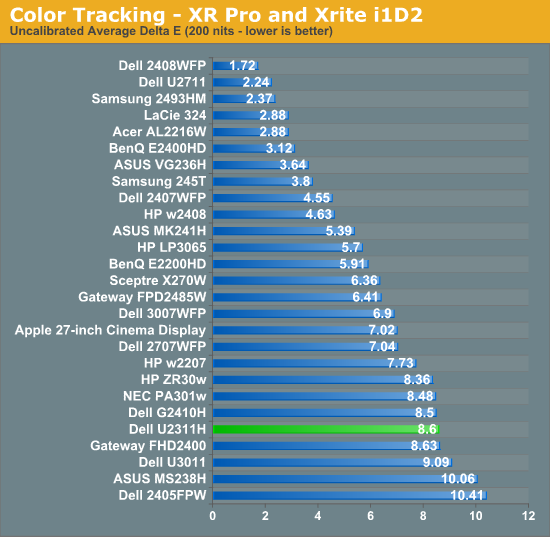
First we looked at the uncalibrated performance with the monitor set to 200 nits and using the include ICM profile from Dell. As you can see, we wind up way off our target dE of 3.0 with an average of 8.6 and a peak value of 14.85. Compared to some other displays this actually isn’t too bad, but it’s nothing you would want to use for serious color work.
For the initial calibration, we used the Custom (RGB) mode on the Dell and calibrated the 100% White Point using the RGB gain controls to be as accurate as possible. We then set calibration targets of 200 nits, D65 for a white point, and a gamma target of 2.2. Once calibrated, we compared the results using the GregTag Macbeth color checker patterns.
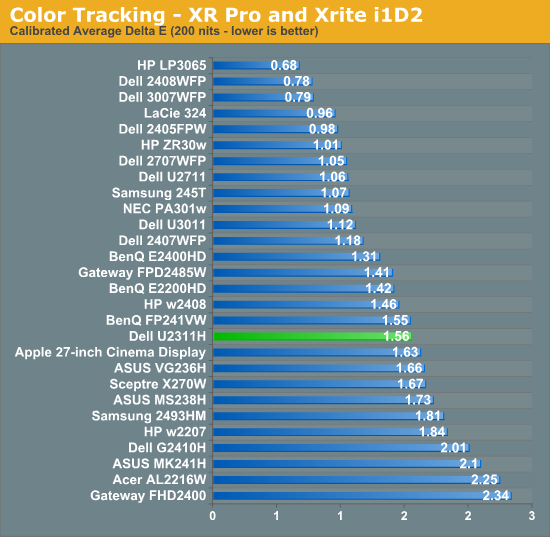
Once we calibrate the Dell, we see our average dE has dropped all the way down to 1.56 and the peak dE is at 5.03. Another thing to keep in mind is that the patches that are generating the highest dE values are ones that are made up mostly of blue. Given your choice, blue is where you want the majority of your dE to occur and green is where you want the least to occur, as the blue light is much lower in light output than red or green, and so errors are not nearly as visible to your eye as they would be in the other colors. Additionally, since the blue light output is much lower, it’s also harder for a colorimeter like the i1D2 to read and therefore more subject to reading errors than green would be. This could account for some of this error and a meter with better dark reading support could resolve that, though most people won’t have one of those for calibrating.
For print work, we then calibrated the monitor using the same specifications, only with a target of 100 nits instead of 200 nits. For a lit room most people would consider this to be too dark of an image, but for print work its much closer to what your actual output would look like.
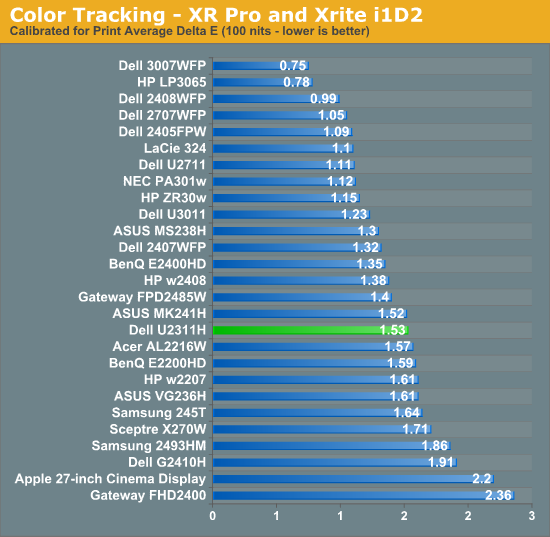
Our average dE here is almost identical at 1.56 but the peak dE is down to 4.75. Again these spikes are occurring in that range that is heavily blue and less noticeable by the human eye. There is a good chance that for the majority of your work you will not have a color error that is visible to the naked eye.


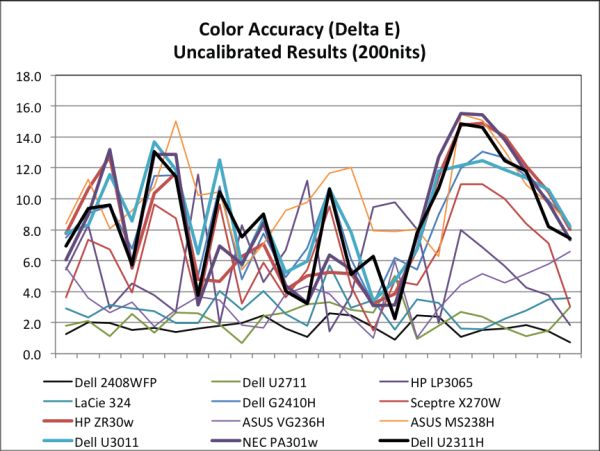
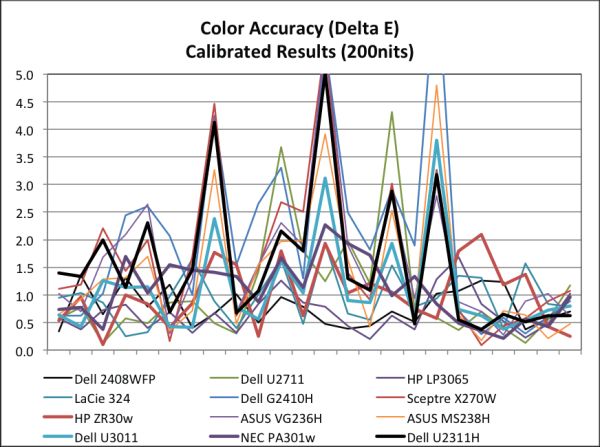
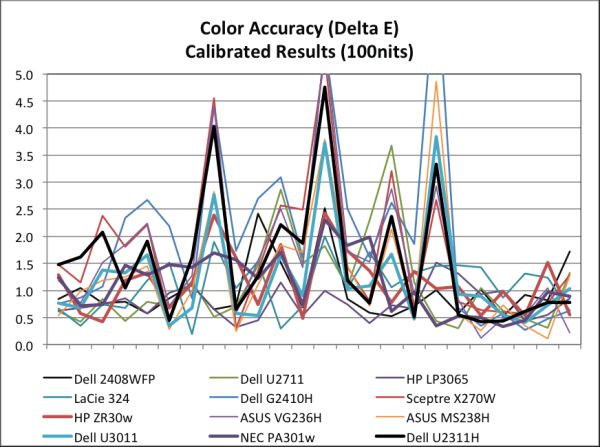








65 Comments
View All Comments
jabber - Tuesday, September 27, 2011 - link
...with just buying a PVA panel instead?Aphelion02 - Tuesday, September 27, 2011 - link
Nice article, but so late as to be dangerously close to being irrelevant. A large amount of people who might have found this useful have already made their purchasing decisions almost a year ago. I have noticed this as quite a trend at AT, with this article and the P8P68 mobo review as being most striking. At some point, the added value of a late review is so minimal you are better off spending the effort on something else.dingetje - Tuesday, September 27, 2011 - link
more 1920x1080 reviews?I like Dell, but here's what I think: they can shove all their 16:9 panels up their @$$
A5 - Tuesday, September 27, 2011 - link
Cool story bro.The market has spoken, and they want cheap 16:9 1080p monitors. Dell isn't going to make a 16:10 monitor that won't sell to satisfy you.
Makaveli - Tuesday, September 27, 2011 - link
Its funny you say that cause Dell already has a 16:10 24' model that is superior to this.The market is also full of dumb ass best buy shoppers!
Dug - Tuesday, September 27, 2011 - link
The market hasn't spoken,No one I have ever spoken too prefers 16:9 to 16:10
And that sentiment is echoed in every forum I come across.
16:9 is what has been shoved down our throats
user1003 - Tuesday, September 27, 2011 - link
This monitor is horrible. The whole stand is nice and adjustable, but the panel itself is plagued with a lot of problems, among them:- tinting (google it, it's a problem with the whole series, and the 24" series too). there are yellow stripes at the screen borders and the whole left side is slightly tinted yellow, too. the area effected by the tinting differs, but a lot of the U23 and U24 Dells have this problem
- the anti glare coating distorts small details like fonts
- the PSU makes a loud humming noise when set to <95% brightness, so you either become blind or deaf
- clouding at the edges
Some of them are better than others so you could get lucky (and let's face it, they sent Anandtech a good one for testing), but overall this monitor just sucks, even considering the low price.
jecs - Tuesday, September 27, 2011 - link
That is too bad. But also makes me feel safe with the higher quality 2470 ultrasharp. This screen is working very well, I have a lot of input connectors to choose from, 1920 x 1200 screen and I have 0 problems after a year of use. But, also remember this new matrices may still be 6 bits for color depth and that LED panels are good on power consumption but not very good for precision color. However I don't know why Dell is having such a product on the market if it not ready. It also makes me wonder if Dell is lowering the quality to appeal to new audiences but instead is disappointing loyal customers.tech6 - Tuesday, September 27, 2011 - link
To all those who complain that this panel is far from perfect for design work: I would have to agree but that's not the market it aims for. For starters, any 1080 panel is no good for layout work so if that's what you're looking for there are a number of $500+ monitors that will meet your needs. This panel is designed as an upgrade to mediocre $200 TN monitors and it does a great job and it does a great job. We bought a number of these for the office last year and they put all other TN panels to shame. For those considering a 1080 work or home display, this is a high quality bargain.Miggleness - Tuesday, September 27, 2011 - link
I've had this monitor for over a year now, hope you can do a followup and put the U2312 to the test as well. You'd definitely be able to get a good assessment on it's improvements over the U2311 (if any) while this review is fresh.